window MINI Clubman 2014 Owner's Guide
[x] Cancel search | Manufacturer: MINI, Model Year: 2014, Model line: Clubman, Model: MINI Clubman 2014Pages: 210, PDF Size: 5.12 MB
Page 105 of 210
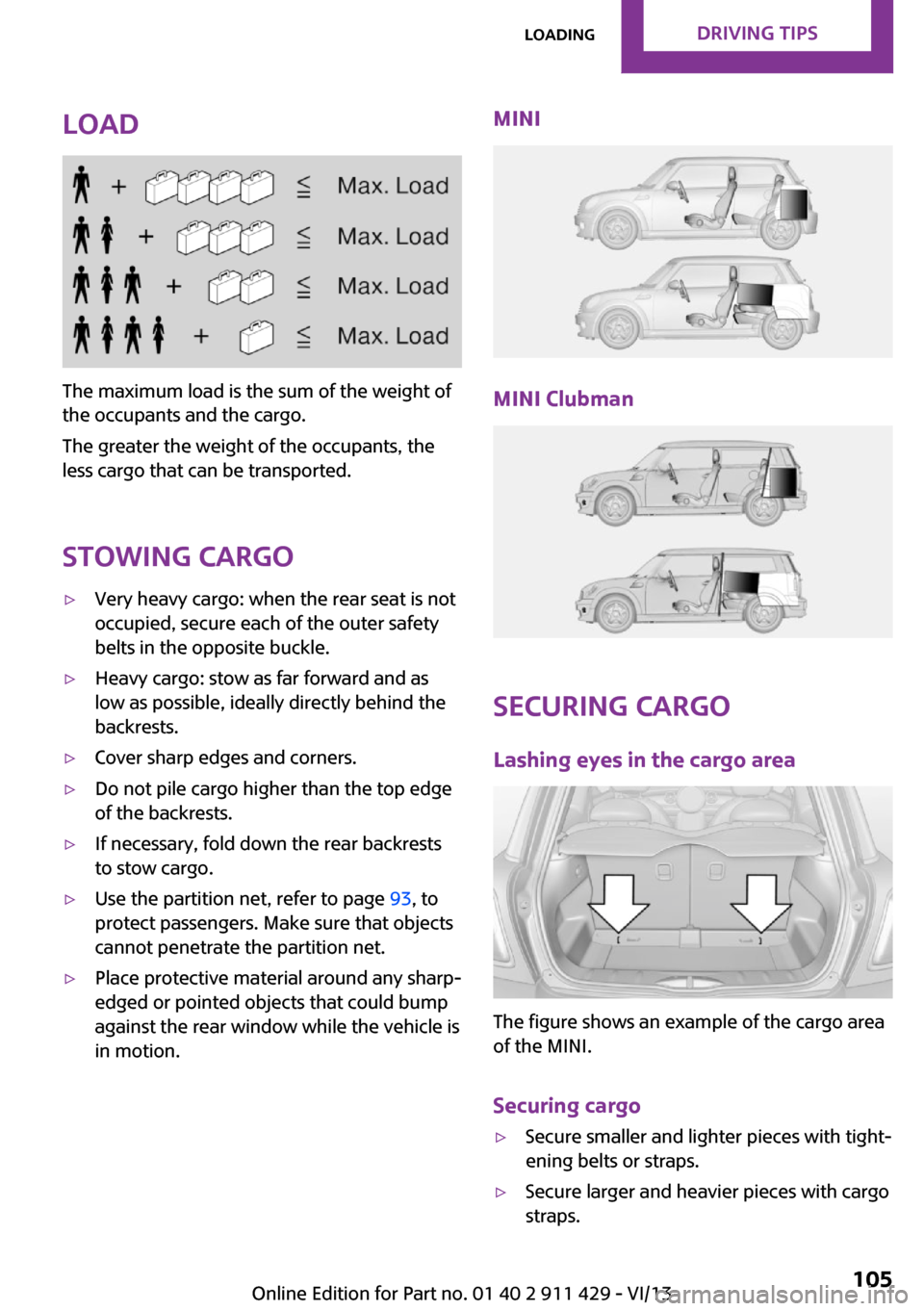
Load
The maximum load is the sum of the weight of
the occupants and the cargo.
The greater the weight of the occupants, the
less cargo that can be transported.
Stowing cargo
▷Very heavy cargo: when the rear seat is not
occupied, secure each of the outer safety
belts in the opposite buckle.▷Heavy cargo: stow as far forward and as
low as possible, ideally directly behind the
backrests.▷Cover sharp edges and corners.▷Do not pile cargo higher than the top edge
of the backrests.▷If necessary, fold down the rear backrests
to stow cargo.▷Use the partition net, refer to page 93, to
protect passengers. Make sure that objects
cannot penetrate the partition net.▷Place protective material around any sharp-
edged or pointed objects that could bump
against the rear window while the vehicle is
in motion.MINI
MINI Clubman
Securing cargo
Lashing eyes in the cargo area
The figure shows an example of the cargo area
of the MINI.
Securing cargo
▷Secure smaller and lighter pieces with tight‐
ening belts or straps.▷Secure larger and heavier pieces with cargo
straps.Seite 105LoadingDriving tips105
Online Edition for Part no. 01 40 2 911 429 - VI/13
Page 108 of 210
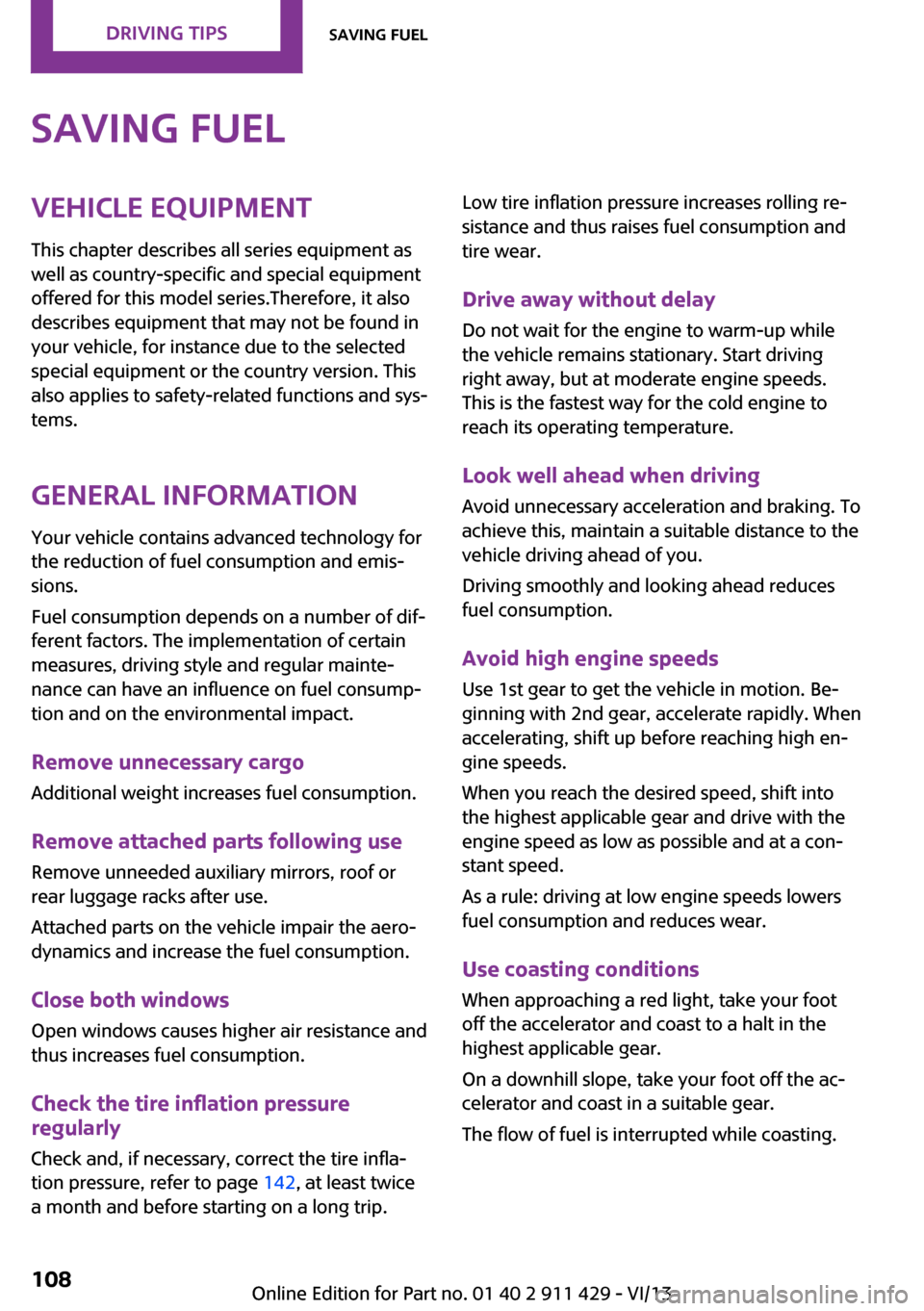
Saving fuelVehicle equipment
This chapter describes all series equipment as
well as country-specific and special equipment
offered for this model series.Therefore, it also
describes equipment that may not be found in
your vehicle, for instance due to the selected
special equipment or the country version. This
also applies to safety-related functions and sys‐
tems.
General information Your vehicle contains advanced technology for
the reduction of fuel consumption and emis‐
sions.
Fuel consumption depends on a number of dif‐
ferent factors. The implementation of certain
measures, driving style and regular mainte‐ nance can have an influence on fuel consump‐
tion and on the environmental impact.
Remove unnecessary cargo Additional weight increases fuel consumption.
Remove attached parts following use Remove unneeded auxiliary mirrors, roof or
rear luggage racks after use.
Attached parts on the vehicle impair the aero‐
dynamics and increase the fuel consumption.
Close both windows Open windows causes higher air resistance and
thus increases fuel consumption.
Check the tire inflation pressure
regularly
Check and, if necessary, correct the tire infla‐
tion pressure, refer to page 142, at least twice
a month and before starting on a long trip.Low tire inflation pressure increases rolling re‐
sistance and thus raises fuel consumption and
tire wear.
Drive away without delayDo not wait for the engine to warm-up while
the vehicle remains stationary. Start driving
right away, but at moderate engine speeds.
This is the fastest way for the cold engine to
reach its operating temperature.
Look well ahead when driving Avoid unnecessary acceleration and braking. To
achieve this, maintain a suitable distance to the
vehicle driving ahead of you.
Driving smoothly and looking ahead reduces
fuel consumption.
Avoid high engine speeds Use 1st gear to get the vehicle in motion. Be‐
ginning with 2nd gear, accelerate rapidly. When
accelerating, shift up before reaching high en‐
gine speeds.
When you reach the desired speed, shift into
the highest applicable gear and drive with the
engine speed as low as possible and at a con‐
stant speed.
As a rule: driving at low engine speeds lowers
fuel consumption and reduces wear.
Use coasting conditions
When approaching a red light, take your foot
off the accelerator and coast to a halt in the
highest applicable gear.
On a downhill slope, take your foot off the ac‐
celerator and coast in a suitable gear.
The flow of fuel is interrupted while coasting.Seite 108Driving tipsSaving fuel108
Online Edition for Part no. 01 40 2 911 429 - VI/13
Page 109 of 210

Switch off the engine during longer
stops
Switch off the engine during longer stops, e.g.,
at traffic lights, railroad crossings or in traffic
congestion.
Fuel savings are already achieved after the en‐
gine is turned off for as little as 4 seconds.
Automatic Engine Start/Stop Function
The Automatic Engine Start/Stop Function auto‐
matically switches the engine off during a stop.
If the engine is stopped and then started again,
fuel consumption and emissions drop com‐
pared to an engine that runs permanently.
Stopping the engine even for just a few sec‐
onds can result in savings.
In addition, fuel consumption depends on other
factors as well, such as driving style, road con‐
ditions, maintenance, and environmental fac‐
tors.
Switch off any functions that are not currently needed
Functions such as seat heating and the rear
window defroster require a lot of energy and
consume additional fuel, especially in city and
stop-and-go traffic.
Therefore, switch off these functions if they are
not actually needed.
Have maintenance carried out
Have vehicles maintained regularly to achieve
optimal vehicle economy and operating life.
Have the maintenance carried out by the serv‐
ice center.
Please also note the MINI maintenance system,
refer to page 160.Seite 109Saving fuelDriving tips109
Online Edition for Part no. 01 40 2 911 429 - VI/13
Page 155 of 210
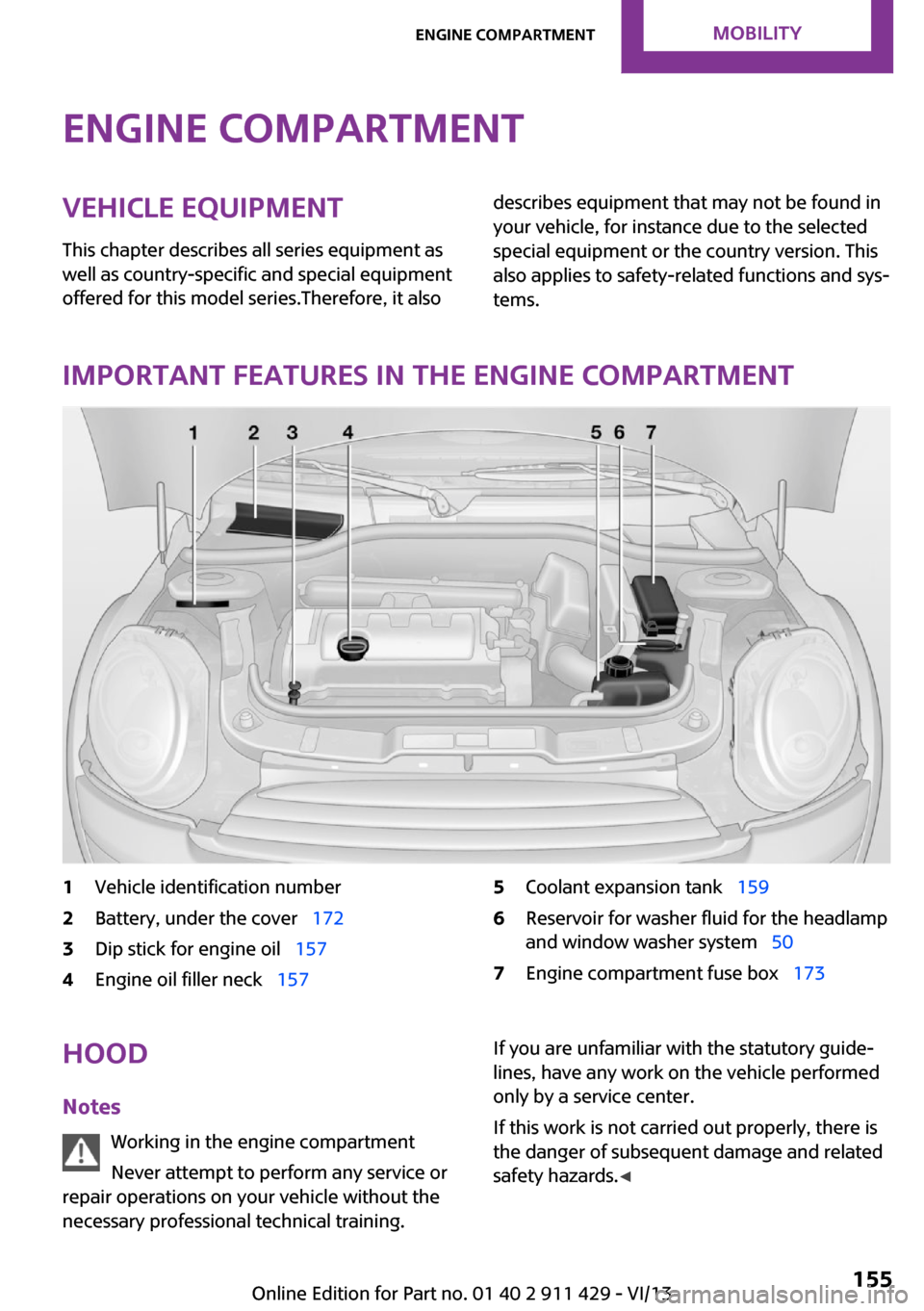
Engine compartmentVehicle equipment
This chapter describes all series equipment as
well as country-specific and special equipment
offered for this model series.Therefore, it alsodescribes equipment that may not be found in
your vehicle, for instance due to the selected
special equipment or the country version. This
also applies to safety-related functions and sys‐
tems.
Important features in the engine compartment
1Vehicle identification number2Battery, under the cover 1723Dip stick for engine oil 1574Engine oil filler neck 1575Coolant expansion tank 1596Reservoir for washer fluid for the headlamp
and window washer system 507Engine compartment fuse box 173Hood
Notes Working in the engine compartment
Never attempt to perform any service or
repair operations on your vehicle without the
necessary professional technical training.If you are unfamiliar with the statutory guide‐
lines, have any work on the vehicle performed
only by a service center.
If this work is not carried out properly, there is
the danger of subsequent damage and related
safety hazards. ◀Seite 155Engine compartmentMobility155
Online Edition for Part no. 01 40 2 911 429 - VI/13
Page 163 of 210

5Special wrench for releasing the compact
wheel6Screwdriver/cross-head7Tow fitting8Lifting handle
MINI Clubman
1Folding wheel chock and cover for the de‐
fective wheel2Vehicle jack3Lug bolts wrench4Pulling hook5Screwdriver/cross-head6Torx insert for screwdriver7Tow fitting
Wiper blade replacement
General information Do not fold down the wipers withoutwiper blades
Do not fold down the wipers if wiper blades
have not been installed; this may damage the
windshield. ◀
Replacing the front wiper blades1.Fold up and hold the wiper arm.2.Squeeze the locking spring, arrows 1.3.While squeezing the locking spring, pull the
wiper blade off of the wiper arm, arrow 2.4.Slide the new wiper blade onto the wiper
arm until it engages audibly.5.Fold down the wiper arm.
Risk of damage
Before opening the hood, ensure that the
wiper arms with wiper blades are folded onto
the window; otherwise, damage may occur. ◀
MINI: replacing the rear wiper blade
1.Fold up and hold the wiper arm.2.Turn the wiper blade all the way back, ar‐
row.3.Press the wiper blade against the stop to
push it out of the fixation.4.Press the new wiper blade into the fixation
until it engages audibly.5.Fold down the wiper arm.Seite 163Replacing componentsMobility163
Online Edition for Part no. 01 40 2 911 429 - VI/13
Page 179 of 210
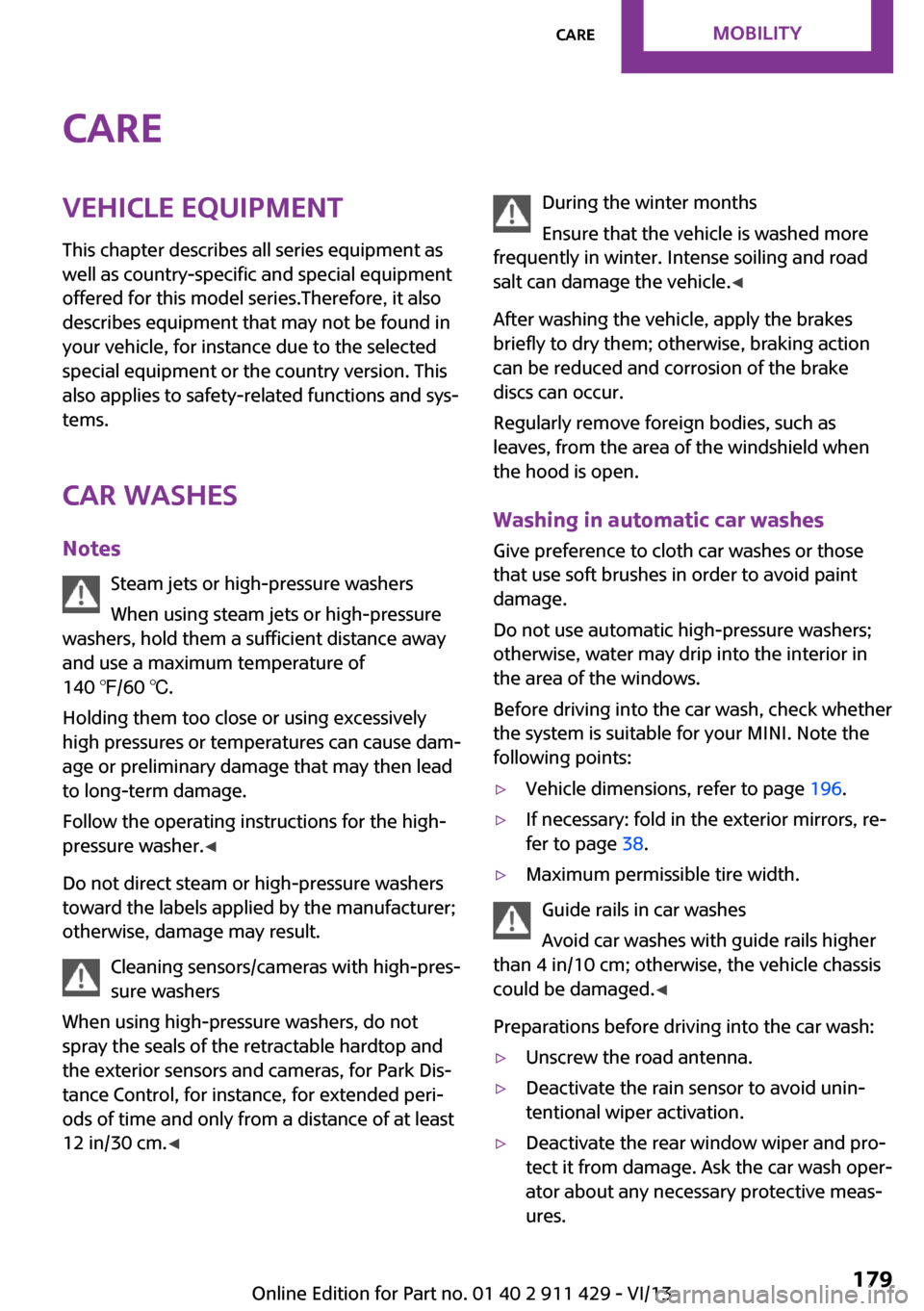
CareVehicle equipmentThis chapter describes all series equipment as
well as country-specific and special equipment
offered for this model series.Therefore, it also
describes equipment that may not be found in
your vehicle, for instance due to the selected
special equipment or the country version. This
also applies to safety-related functions and sys‐
tems.
Car washes Notes Steam jets or high-pressure washers
When using steam jets or high-pressure
washers, hold them a sufficient distance away
and use a maximum temperature of
140 ℉/60 ℃.
Holding them too close or using excessively
high pressures or temperatures can cause dam‐
age or preliminary damage that may then lead
to long-term damage.
Follow the operating instructions for the high-
pressure washer. ◀
Do not direct steam or high-pressure washers
toward the labels applied by the manufacturer;
otherwise, damage may result.
Cleaning sensors/cameras with high-pres‐
sure washers
When using high-pressure washers, do not
spray the seals of the retractable hardtop and
the exterior sensors and cameras, for Park Dis‐ tance Control, for instance, for extended peri‐ods of time and only from a distance of at least
12 in/30 cm. ◀During the winter months
Ensure that the vehicle is washed more
frequently in winter. Intense soiling and road
salt can damage the vehicle. ◀
After washing the vehicle, apply the brakes
briefly to dry them; otherwise, braking action
can be reduced and corrosion of the brake
discs can occur.
Regularly remove foreign bodies, such as
leaves, from the area of the windshield when
the hood is open.
Washing in automatic car washes Give preference to cloth car washes or those
that use soft brushes in order to avoid paint
damage.
Do not use automatic high-pressure washers;
otherwise, water may drip into the interior in
the area of the windows.
Before driving into the car wash, check whether
the system is suitable for your MINI. Note the
following points:▷Vehicle dimensions, refer to page 196.▷If necessary: fold in the exterior mirrors, re‐
fer to page 38.▷Maximum permissible tire width.
Guide rails in car washes
Avoid car washes with guide rails higher
than 4 in/10 cm; otherwise, the vehicle chassis
could be damaged. ◀
Preparations before driving into the car wash:
▷Unscrew the road antenna.▷Deactivate the rain sensor to avoid unin‐
tentional wiper activation.▷Deactivate the rear window wiper and pro‐
tect it from damage. Ask the car wash oper‐
ator about any necessary protective meas‐
ures.Seite 179CareMobility179
Online Edition for Part no. 01 40 2 911 429 - VI/13
Page 180 of 210
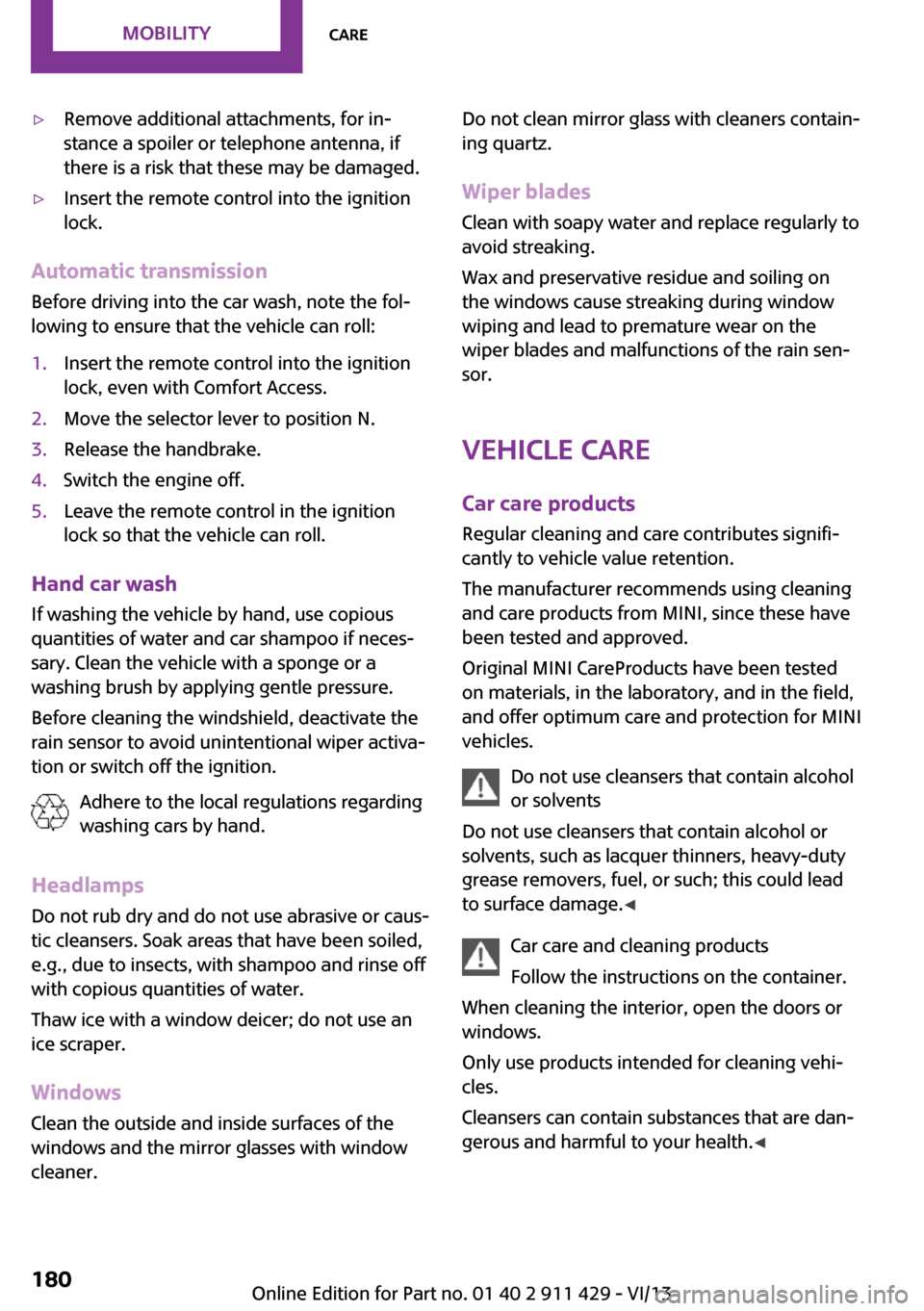
▷Remove additional attachments, for in‐
stance a spoiler or telephone antenna, if
there is a risk that these may be damaged.▷Insert the remote control into the ignition
lock.
Automatic transmission
Before driving into the car wash, note the fol‐
lowing to ensure that the vehicle can roll:
1.Insert the remote control into the ignition
lock, even with Comfort Access.2.Move the selector lever to position N.3.Release the handbrake.4.Switch the engine off.5.Leave the remote control in the ignition
lock so that the vehicle can roll.
Hand car wash
If washing the vehicle by hand, use copious
quantities of water and car shampoo if neces‐
sary. Clean the vehicle with a sponge or a
washing brush by applying gentle pressure.
Before cleaning the windshield, deactivate the
rain sensor to avoid unintentional wiper activa‐
tion or switch off the ignition.
Adhere to the local regulations regarding
washing cars by hand.
Headlamps
Do not rub dry and do not use abrasive or caus‐
tic cleansers. Soak areas that have been soiled,
e.g., due to insects, with shampoo and rinse off
with copious quantities of water.
Thaw ice with a window deicer; do not use an
ice scraper.
Windows Clean the outside and inside surfaces of the
windows and the mirror glasses with window
cleaner.
Do not clean mirror glass with cleaners contain‐
ing quartz.
Wiper blades
Clean with soapy water and replace regularly to
avoid streaking.
Wax and preservative residue and soiling on
the windows cause streaking during window
wiping and lead to premature wear on the
wiper blades and malfunctions of the rain sen‐
sor.
Vehicle care Car care products
Regular cleaning and care contributes signifi‐
cantly to vehicle value retention.
The manufacturer recommends using cleaning
and care products from MINI, since these have
been tested and approved.
Original MINI CareProducts have been tested
on materials, in the laboratory, and in the field,
and offer optimum care and protection for MINI
vehicles.
Do not use cleansers that contain alcohol
or solvents
Do not use cleansers that contain alcohol or
solvents, such as lacquer thinners, heavy-duty
grease removers, fuel, or such; this could lead
to surface damage. ◀
Car care and cleaning products
Follow the instructions on the container.
When cleaning the interior, open the doors or
windows.
Only use products intended for cleaning vehi‐
cles.
Cleansers can contain substances that are dan‐
gerous and harmful to your health. ◀Seite 180MobilityCare180
Online Edition for Part no. 01 40 2 911 429 - VI/13
Page 201 of 210
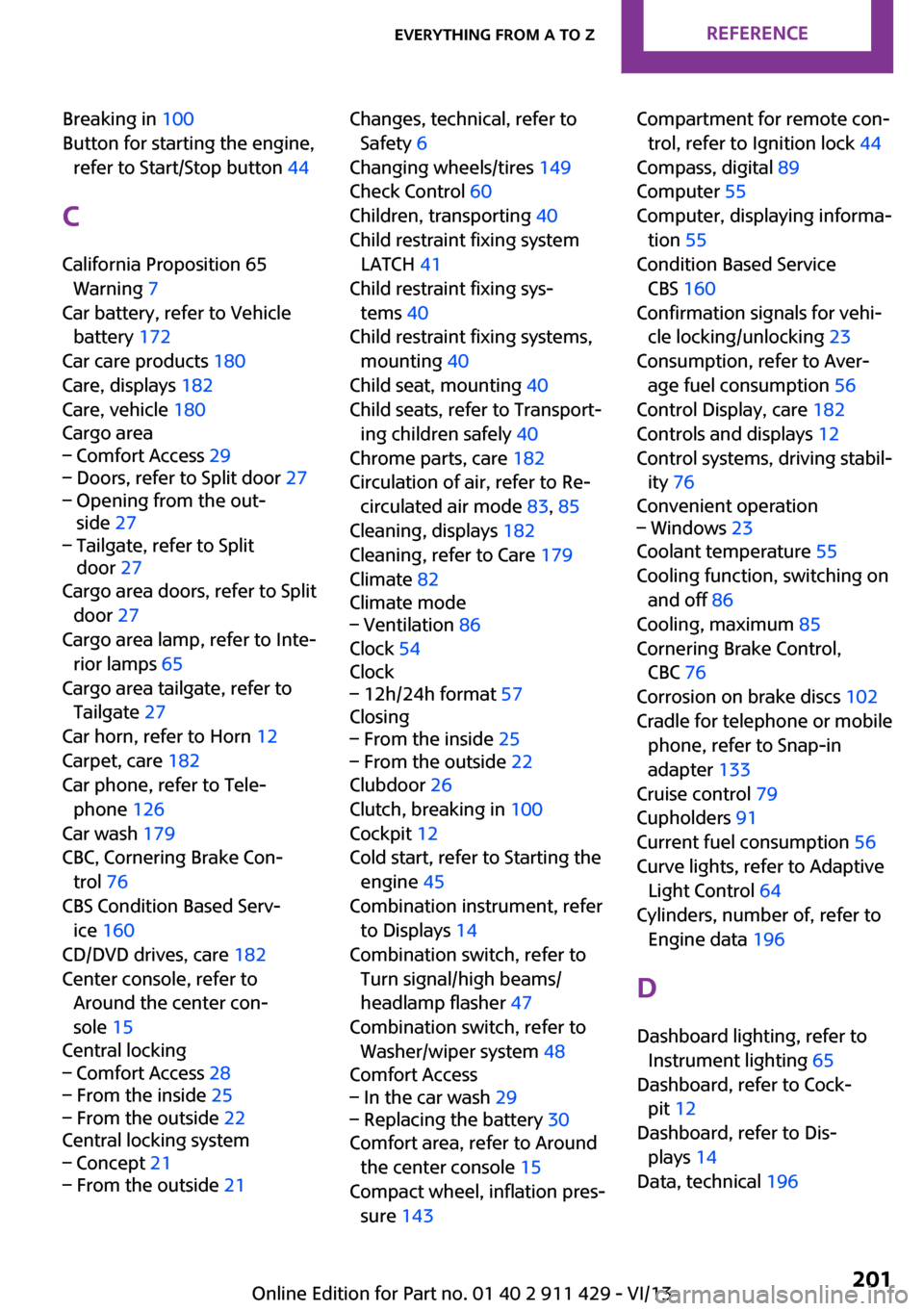
Breaking in 100
Button for starting the engine, refer to Start/Stop button 44
C
California Proposition 65 Warning 7
Car battery, refer to Vehicle battery 172
Car care products 180
Care, displays 182
Care, vehicle 180
Cargo area– Comfort Access 29– Doors, refer to Split door 27– Opening from the out‐
side 27– Tailgate, refer to Split
door 27
Cargo area doors, refer to Split
door 27
Cargo area lamp, refer to Inte‐ rior lamps 65
Cargo area tailgate, refer to Tailgate 27
Car horn, refer to Horn 12
Carpet, care 182
Car phone, refer to Tele‐ phone 126
Car wash 179
CBC, Cornering Brake Con‐ trol 76
CBS Condition Based Serv‐ ice 160
CD/DVD drives, care 182
Center console, refer to Around the center con‐
sole 15
Central locking
– Comfort Access 28– From the inside 25– From the outside 22
Central locking system
– Concept 21– From the outside 21Changes, technical, refer to
Safety 6
Changing wheels/tires 149
Check Control 60
Children, transporting 40
Child restraint fixing system LATCH 41
Child restraint fixing sys‐ tems 40
Child restraint fixing systems, mounting 40
Child seat, mounting 40
Child seats, refer to Transport‐ ing children safely 40
Chrome parts, care 182
Circulation of air, refer to Re‐ circulated air mode 83, 85
Cleaning, displays 182
Cleaning, refer to Care 179
Climate 82
Climate mode– Ventilation 86
Clock 54
Clock
– 12h/24h format 57
Closing
– From the inside 25– From the outside 22
Clubdoor 26
Clutch, breaking in 100
Cockpit 12
Cold start, refer to Starting the engine 45
Combination instrument, refer to Displays 14
Combination switch, refer to Turn signal/high beams/
headlamp flasher 47
Combination switch, refer to Washer/wiper system 48
Comfort Access
– In the car wash 29– Replacing the battery 30
Comfort area, refer to Around
the center console 15
Compact wheel, inflation pres‐ sure 143
Compartment for remote con‐
trol, refer to Ignition lock 44
Compass, digital 89
Computer 55
Computer, displaying informa‐ tion 55
Condition Based Service CBS 160
Confirmation signals for vehi‐ cle locking/unlocking 23
Consumption, refer to Aver‐ age fuel consumption 56
Control Display, care 182
Controls and displays 12
Control systems, driving stabil‐ ity 76
Convenient operation– Windows 23
Coolant temperature 55
Cooling function, switching on and off 86
Cooling, maximum 85
Cornering Brake Control,
CBC 76
Corrosion on brake discs 102
Cradle for telephone or mobile phone, refer to Snap-in
adapter 133
Cruise control 79
Cupholders 91
Current fuel consumption 56
Curve lights, refer to Adaptive Light Control 64
Cylinders, number of, refer to Engine data 196
D
Dashboard lighting, refer to Instrument lighting 65
Dashboard, refer to Cock‐ pit 12
Dashboard, refer to Dis‐ plays 14
Data, technical 196
Seite 201Everything from A to ZReference201
Online Edition for Part no. 01 40 2 911 429 - VI/13
Page 202 of 210

Date– Display format 57– Setting 58
Daytime running lights 63
Decorative trim, care 182
Defogging windows 83
Defroster
– Rear window 83, 86
Defrosting windows 83
Defrost setting, refer to De‐ frosting windows 83
Digital compass 89
Dip stick, engine oil 157
Directional indicators, refer to Turn signals 47
Displacement, refer to Engine data 196
Display lighting, refer to In‐ strument lighting 65
Displays 14
Displays and controls 12
Displays, care 182
Displays, cleaning 182
Displays, refer to Instrument cluster 14
Disposal
– Remote control battery 30
Distance warning, refer to
Park Distance Control
PDC 80
Door
– Rear, refer to Clubdoor 26
Door key, refer to Remote
control with integrated
key 20
Door lock 24
Door lock, confirmation sig‐ nals 23
Doors, manual operation 25
Doors, unlocking and locking
– Confirmation signals 23– From the inside 25– From the outside 22
DOT Quality Grades 147
Drive-off assistant, refer to Hill drive-off assistant 78
Driving notes, breaking
in 100
Driving off on hills, refer to Hill drive-off assistant 78
Driving stability control sys‐ tems 76
Driving tips, refer to Driving notes 100
Dry air, refer to Cooling func‐ tion 86
DSC Dynamic Stability Con‐ trol 76
DTC Dynamic Traction Con‐ trol 77
Dynamic Stability Control DSC 76
Dynamic Traction Control DTC 77
E Electrical malfunction– Door lock 25– Fuel filler flap 138
Electronic brake-force distri‐
bution 76
Electronic Stability Program ESP, refer to Dynamic Stabil‐
ity Control DSC 76
Emergency activation
– Automatic transmission, re‐
fer to Overriding selector
lever lock 53
Emergency operation, fuel
filler flap, unlocking man‐
ually 138
Emergency operation, refer to
Manual operation
– Door lock 25
Energy, saving, refer to Saving
fuel 108
Engine, breaking in 100
Engine compartment 155
Engine oil, adding 157
Engine oil, additives, refer to Approved engine oils 158
Engine oil, alternative oil
types 158
Engine oil change intervals, refer to Service require‐
ments 59
Engine oil, dip stick 157
Engine oil, filling capacity 199
Engine oil, MINI maintenance system 160
Engine oil types, alterna‐ tive 158
Engine oil types, ap‐ proved 158
Engine, overheating, refer to Coolant temperature 55
Engine power, refer to Engine data 196
Engine, RPM 196
Engine start, assistance 175
Engine, starting 45
Engine, starting– Comfort Access 28
Engine, starting, Start/Stop
button 44
Engine, stopping, Start/Stop button 44
Engine, switching off 46
Equipment, interior 87
ESP Electronic Stability Pro‐ gram, refer to Dynamic Sta‐
bility Control DSC 76
Exchanging wheels/tires 149
Exterior mirrors 38
Exterior mirrors, adjusting 38
Exterior mirrors, folding in and out 38
Exterior sensors, care 182
External temperature dis‐ play 54
External temperature display
– Changing the units 57– On the computer 57
External temperature warn‐
ing 54
Externel temperature dis‐ play 54
Seite 202ReferenceEverything from A to Z202
Online Edition for Part no. 01 40 2 911 429 - VI/13
Page 203 of 210

FFailure messages, refer to Check Control 60
False alarm, refer to Avoiding unintentional alarms 30
Fastening safety belts, refer to Safety belts 36
Fault messages, refer to Check Control 60
Filling capacities 199
Filter– Refer to Activated-charcoal
filter 84– Refer to Microfilter 84– Refer to Microfilter/acti‐
vated-charcoal filter with
automatic climate control 86
First aid kit 174
First aid, refer to First aid kit 174
Flashing when locking/unlock‐ ing 23
Flat tire
– Flat Tire Monitor 70– Indicator/warning lamp 70– Run-flat tire 71– Tire Pressure Monitor
TPM 72
Flat Tire Monitor FTM 69
Flat Tire Monitor FTM
– Flat tire message 70– Initializing the system 70– Limits of the system 70– Snow chains 70
Flat tire, wheel change 170
Floor mats, care 182
Fog lamps 65
Foot brake 102
Footwell lamps, refer to Inte‐ rior lamps 65
Front airbags 67
Front fog lamp, bulb replace‐ ment 166
Front fog lamps 65
Front lamps, bulb replace‐ ment 165
Front passenger airbags, de‐
activating 68
FTM Flat Tire Monitor 69
Fuel 140
Fuel– Refer to Average fuel con‐
sumption 56
Fuel, additives 140
Fuel, average consump‐ tion 56
Fuel cap, closing 138
Fuel consumption display
– Average fuel consump‐
tion 56
Fuel filler flap, closing 138
Fuel filler flap, opening 138
Fuel filler flap, unlocking in case of an electrical malfunc‐
tion 138
Fuel gauge 55
Fuel, saving 108
Fuel tank capacity, refer to Filling capacities 199
Fuel tank contents, refer to Filling capacities 199
Fuel tank, refer to Filling ca‐ pacities 199
Fuse 173
G Garage door opener, refer to Universal garage door
opener 87
Gasoline 140
Gasoline gauge, refer to Fuel gauge 55
Gasoline quality 140
Gear change
– Automatic transmission with
Steptronic 52
Gear display, automatic trans‐
mission with Steptronic 51
Glass sunroof, electrical 31
Glass sunroof, electrical– Convenient operation 23– Opening, closing 31– Raising 31– Remote control 23
H
Halogen headlamps, bulb re‐ placement 165
Hand car wash, care 180
Hand-held transmitter, alter‐ nating code 88
Hands-free microphone 15
Hazard warning system 15
Head airbags 67
Headlamp control, auto‐ matic 62
Headlamp courtesy delay fea‐ ture 64
Headlamp flasher 47, 63
Headlamps 62
Headlamps, care 180
Headlamps, cleaning, washer fluid 50
Head restraints 37
Head restraints
– Adjusting the height 37– Removing 37
Heatable
– Windshield 86
Heating
– Rear window 83, 86– Seats 36– Windshield 86
Height adjustment
– Seats 34
High beams 63
High beams, bulb replace‐ ment 165
Hill drive-off assistant 78
Hills 102
Holder for remote control, re‐ fer to Ignition lock 44
Homepage 6
Hood 155
Hood, closing 156
Seite 203Everything from A to ZReference203
Online Edition for Part no. 01 40 2 911 429 - VI/13